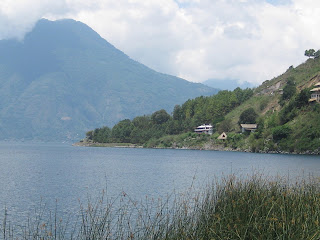 For me, there isn’t much to do in Panajachel at night except to eat out at one of the many touristy restaurants whose menus range from typical Guatemalan dishes ($) to French gourmet ($$). There is however a restaurant called Solomon’s Porch that promotes itself as a cultural center. The owners organize a monthly program of live music, movies, and “Guatemala Lecture Series.” Once a month, local politicians, social activists, and retired academics are invited to give a talk with is then followed by a discussion. The two talks I have gone to were in English and the audience was 99% gringos (the remaining 1% were Guatemalan restaurant workers).
For me, there isn’t much to do in Panajachel at night except to eat out at one of the many touristy restaurants whose menus range from typical Guatemalan dishes ($) to French gourmet ($$). There is however a restaurant called Solomon’s Porch that promotes itself as a cultural center. The owners organize a monthly program of live music, movies, and “Guatemala Lecture Series.” Once a month, local politicians, social activists, and retired academics are invited to give a talk with is then followed by a discussion. The two talks I have gone to were in English and the audience was 99% gringos (the remaining 1% were Guatemalan restaurant workers). On Thursday, May 14th I went to a talk entitled “Thoughts about Resignation on 2012: Guatemalan Perspectives” given by anthropologist and author Robert Hinshaw who has lived and done research in Guatemala since 1963 on change and continuity in Maya belief patterns. His current interest is climate change and its impact on Maya culture. This was the focus of his talk and an essay he wrote entitled “A Manifest of Resignation.” (For a copy of the essay, contact Robert Hinshaw at robhinshaw@msn.com.) At the end of the discussion, he invited the audience to an inauguration ceremony in Tzununa, one of the poorer, more isolated villages on the Lake. He explained that he and his wife had donated a piece of their property to an organization “Los Amigos de Santa Cruz” so that they could build an educational center for women and children from the village. I decided that that this was an opportunity I would not pass up and asked my friend Bernadette if she wanted to come with me.
The following week on Wednesday, May 20th, we took a boat over to Tzununa, “hummingbird of the water” in Kaqchikel. Due to its remoteness, inhabitants have been very shy toward foreigners; however, since the roadways have improved, more outsiders are coming in and buying up land to built vacation homes. The inhabitants produce oranges and lemons as their major crops. The trajes (traditional dress) the women wear are stunningly beautiful; their headdress is equally eye-catching.
Women waiting for the Inauguration to begin
Woman wearing a traditional huipil (blouse)
We arrived at the location of the inauguration at 9:00, the time it was supposed to begin, but of course, in Guatemala, everything begins much later. As we waited, I feasted my eyes on the gorgeously clad women trailing in with their children. The facial features of Maya women are striking; they have smooth coffee-colored complexions, pronounced cheekbones, and straight, refined noses.
When the group from Santa Cruz (two towns down on the Lake) arrived an hour later, the ceremony began. People who stood up to give their thanks spoke in Spanish to the foreign visitors and Kaqchikel to the locals. They expressed their gratitude to Robert Hinshaw for his donation of land as well as the founders and current members of Amigos de Santa Cruz who funded the project.
Inauguration Celebration
According to their website, Los Amigos was founded in 1998 by a group of expatriates living in Santa Cruz who, along with local community leaders, sought to empower women and children through education at the primary and secondary level. Public school in Guatemala costs money- not much but enough to prevent poor families from sending all of their children to school. If one child can go, it is the oldest boy. For this reason, very few women are literate and most young women have no future other than having and taking care of children. For this reason, the new educational center is focused on the education of women with regard to literacy, hygiene, nutrition, and job training. For more information about this organization and its achievements, go to: http://www.amigosdesantacruz.org/Amigos_de_Santa_Cruz/HOME.html
After the testimonials, Robert Hinshaw cut the ribbon symbolizing the official opening of the center. People lined up to sign the guestbook. After that, the women sat under the pavilion and had their first class on nutrition. Plates of fresh tamales were passed out at the end of the lesson.
Robert Hinshaw cutting the ribbon
The Guestbook
Attending their first class on nutrition
It was a very beautiful, touching event. In a country where there are rampant poverty, brutality, and tremendous disparity, events as these do provide glimmers of hope and possibility of change. For me, they are also a testament to the goodness of the human spirit which is so often lost or simply imperceptible.
On their way home























